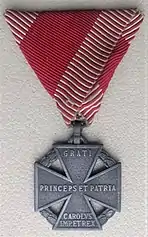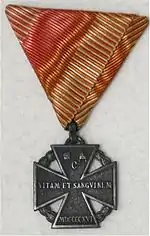Karl Troop Cross
The Karl Troop Cross (German: Karl-Truppenkreuz) was instituted on 13 December 1916 by Emperor Karl I of Austria-Hungary. The cross was awarded until the end of the First World War to soldiers of the Austro-Hungarian Army, regardless of rank, who had been with a combatant unit for at least twelve weeks and who had actually served at the front.
| Karl Troop Cross Karl-Truppenkreuz | |
|---|---|
  Karl Troop Cross, obverse and reverse | |
| Type | Campaign medal |
| Awarded for | At least 12 weeks of service with a combat unit, with service at the front |
| Presented by | Austria-Hungary |
| Eligibility | Soldiers of the Austro-Hungarian Army |
| Campaign(s) | World War I |
| Established | 13 December 1916 |
Karl Troop Cross ribbon bar | |
| Precedence | |
| Next (higher) | Commemorative Cross 1912-13 |
| Next (lower) | Long Service Cross for NCOs and Enlisted Men |
The medal is of zinc and consists of a cross pattée resting on a laurel wreath. The obverse bears the Latin inscription "GRATI PRINCEPS ET PATRIA, CAROLVS IMP.ET REX", (A grateful prince and country, Karl, Emperor and King). The reverse shows the Austrian Imperial and Hungarian Royal crowns above the letter "C" (for Carolus) with the inscription "VITAM ET SANGVINEM", (With life and blood) and the date MDCCCCXVI, (1916). The design is based on the design of the Army Cross of 1813-1814 (usually known as the ‘Cannon Cross’ – ‘Kanonenkreuz’).
The cross was worn on the left chest from a red ribbon with alternate red-white side strips towards each edge.
A total of 651,000 were awarded.
Sources
- Johann Stolzer/Christian Steeb Österreichs Orden vom Mittelalter bis zur Gegenwart, Akademische Druck- und Verlagsanstalt Graz, ISBN 3-201-01649-7